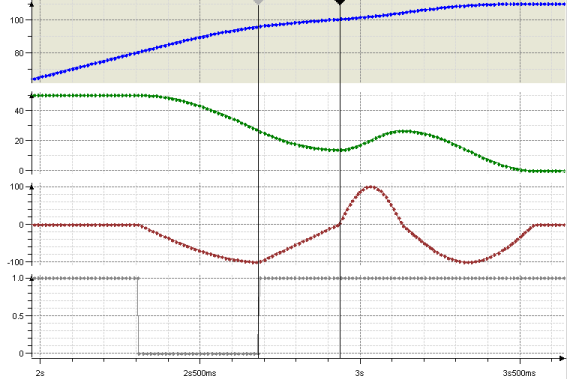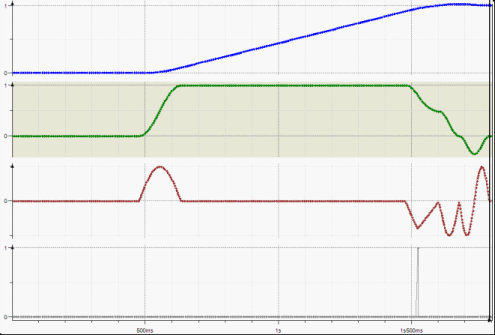Interrupting Single-Axis Motion
Interruption during the deceleration phase
Single-axis motion, such as MC_MoveAbsolute, can be interrupted by other motion at any time. This can be a motion to another position or a change of velocity or acceleration. Basically, the interruption of motion is implemented by another one in such a way that there is no jump in the velocity. For all ramp types (except trapezoid), there is also no jump in the acceleration. When the ramp types sin² and quadratic (smooth) are used, a reversal can occur during interruption and does not appear necessary at first (see explanation). Then the new target position is overtraveled, although it is not located before the old target position. This can occur in the following situations:
If a smaller maximum deceleration value is set than before for the canceled movement. In this case, the available deceleration distance to the new target position is possibly too short (for all ramp types).
Accordingly, for ramp types quadratic and quadratic (smooth) when a lower maximum value is set for jerk.
However, if these maximum values remain unchanged (or increase), then the following rules apply:
For ramp types trapezoid and quadratic, there is never any overtraveling.
For ramp type sin², there is not overtraveling when the new target position and the limiting values for acceleration and deceleration are equal to the old values.
In all other cases, there may be overtraveling with ramp type sin² and quadratic (smooth).
See also
Comments about overtraveling the target position (ramp type sin²)
When single-axis motion is started, the motion profile is computed first (meaning that the phases in which motion is accelerated, run at constant velocity, or decelerated. For ramp type sin², a sin² curve is laid over the acceleration/deceleration phase. The sin² curve has the property of having the acceleration equal to zero before and after, therefore allowing for constant transition to other phases.
A special behavior results when a motion is interrupted during a sin² curve. If the current acceleration does not equal zero, then a sin² curve cannot be started because it is required to start with acceleration 0.
Because the sin² curve profile guarantees a constant acceleration curve to the user, the trajectory generator therefore ramps the acceleration value down to zero. It uses the jerk input of the function block and, if this value is zero, also the jerk value set in the controller configuration (fRampJerk).
The following chart shows the interruption behavior: The signals of position, velocity, acceleration, and from Execute of the interrupted block are shown from top to bottom. Beginning with the rising edge of Execute, the acceleration is reduced linearly to zero, before a new sin² profile is connected (phase between the vertical tick marks).

Note
If the jerk value selection is too low as related to the acceleration, then this phase can be too long and the block may lead to an apparently uncontrolled run. The jerk value should be selected so that the downramping of the acceleration takes only a few milliseconds (for example, with a maximum acceleration of 10,000 u/s2 and a jerk of 1,000,000 u/s3, this phase takes 10ms at most).
Overtraveling the target position

A movement from position 0 to position 1 was started with a specific velocity value of 1 u/s and acceleration value 10 u/s2. Shortly before reaching the target position when the deceleration has already been set, a new motion command interrupts with a new target position of 1.01. Due to the acceleration downramping phase immediately after starting the second motion, the axis travels a distance which means that the axis must travel beyond the target and then it must be returned.